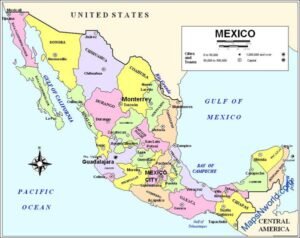Geography of Mexico • Maps • Interesting Facts • Flag
Mexico fact Sheet:
- Area: 1,964,375 km ²
- Population: Over 130 Million
- Population Density: ~16 people/ km ²
- Climate Type: Mostly subtropical
- Dominant Language: Spanish
- Dominant Religion: Christianity
- Currency: Peso(ARS)
- Government: Federal presidential republic
- GDP: 2.84 Trillion USD in 2024
- Major Export: Cars, Computers, Vehicle parts/accessories, Crude petroleum
- Capital:Mexico City
Mexico Flag:

The flag has three equal vertical bands of green (hoist side), white, and red; Mexico’s coat of arms (an eagle with a snake in its beak perched on a cactus) is centered in the white band; green signifies hope, joy, and love; white represents peace and honesty; red stands for hardiness, bravery, strength, and valor; the coat of arms is derived from a legend that the wandering Aztec people were to settle at a location where they would see an eagle on a cactus eating a snake;
History of Mexico:
The first organized culture in Mexico, the Olmec people, appeared in the southeast of the nation in 1200 B.C. Afterwards, the Maya, Toltec, and Aztec peoples came after them.
The ancient cultures of Mexico constructed enormous pyramids and magnificent buildings, produced amazing artwork, and even studied the stars and planets to calculate the best times to perform rituals and cultivate crops.
Mexico was first colonized by the Spanish in the early 1500s. Smallpox and other illnesses carried by the Spanish left the Aztec people ill. Additionally, Tenochtilán, the Aztec capital, was taken over and demolished by the Spaniards. Mexico was governed by the Spanish until 1821.
Geography of Mexico:
Mexico is a country with vast deserts in the north, high mountains and deep gorges in the center, and rich rain forests in the east and south.
Most of Mexico is covered with mountains. On the Central Plateau, there are small mountain ranges situated between the Sierra Madre Occidental and Oriental mountain ranges. These areas are abundant in priceless metals like copper and silver.
The southeast tip of Mexico forms the Yucatán Peninsula, a peninsula that extends into the Gulf of Mexico. The ancient Maya civilization, whose magnificent structures can still be seen today, once called this place home.
Mexico Political Map

Mexico Interesting Facts:
- Mexico is home to 35 UNESCO world heritage sites
- The dinosaur-killing comet made landfall in Mexico: Although this isn’t a particularly intriguing truth about Mexico for our extinct dinosaur companions, it is an important fact about world history. The Yucatan Peninsula was struck by the comet that created the Chicxulub Crater, which is what is now known as the mass extinction event that wiped off the dinosaurs. Although part of the crater at Chicxulub Pueblo, after which it is named, is visible, the spot’s center lies in the ocean.
-
World’s largest pyramid : Although Egypt is perhaps the nation most associated with pyramids, one of the most fascinating things to know about Mexico is that it is home to the largest pyramid in the world—at least in terms of volume. Though not as old as Giza, the Great Pyramid of Cholula, just outside of Puebla, is bigger.
-
World’s largest crystal caves: The Naica Mine — aptly nicknamed The Cave of the Crystals — is the largest crystal cave in the world. The largest crystals there measure 36 feet (11 meters) and can be found at a depth of 300 meters in the state of Chihuahua.
-
World’s Largest exporter of beer: Mexico exports almost $6 billion worth of beer, making it the world’s largest exporter. In fact, Mexico’s beer exports represent over one-third of the worldwide beer export.
Geography of Brazil: Watch now
A hidden gem nestled in the mountains of Europe Watch now
Read about Argentina here: Argentina